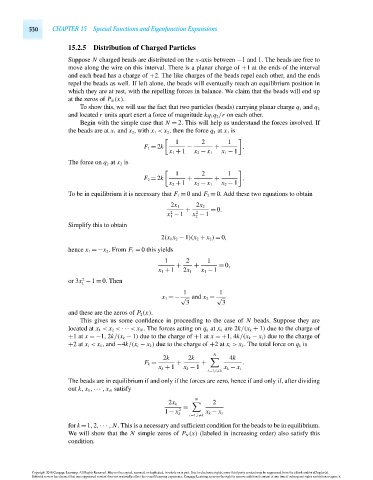Page 550 - Advanced_Engineering_Mathematics o'neil
P. 550
530 CHAPTER 15 Special Functions and Eigenfunction Expansions
15.2.5 Distribution of Charged Particles
Suppose N charged beads are distributed on the x-axis between −1 and 1. The beads are free to
move along the wire on this interval. There is a planar charge of +1 at the ends of the interval
and each bead has a charge of +2. The like charges of the beads repel each other, and the ends
repel the beads as well. If left alone, the beads will eventually reach an equilibrium position in
which they are at rest, with the repelling forces in balance. We claim that the beads will end up
at the zeros of P N (x).
To show this, we will use the fact that two particles (beads) carrying planar charge q 1 and q 2
and located r units apart exert a force of magnitude kq 1 q 2 /r on each other.
Begin with the simple case that N = 2. This will help us understand the forces involved. If
the beads are at x 1 and x 2 , with x 1 < x 2 , then the force q 1 at x 1 is
1 2 1
F 1 = 2k − + .
x 1 + 1 x 2 − x 1 x 1 − 1
The force on q 2 at x 2 is
1 2 1
F 2 = 2k + + .
x 2 + 1 x 2 − x 1 x 2 − 1
To be in equilibrium it is necessary that F 1 = 0 and F 2 = 0. Add these two equations to obtain
2x 1 2x 2
+ = 0.
2
2
x − 1 x − 1
1
2
Simplify this to obtain
2(x 1 x 2 − 1)(x 2 + x 2 ) = 0,
hence x 1 =−x 2 .From F 1 = 0 this yields
1 2 1
+ + = 0,
x 1 + 1 2x 1 x 1 − 1
2
or 3x − 1 = 0. Then
1
1 1
x 1 =−√ and x 2 = √
3 3
and these are the zeros of P 2 (x).
This gives us some confidence in proceeding to the case of N beads. Suppose they are
located at x 1 < x 2 < ··· < x N . The forces acting on q k at x k are 2k/(x k + 1) due to the charge of
+1at x =−1, 2k/(x k − 1) due to the charge of +1at x =+1, 4k/(x k − x i ) due to the charge of
+2at x i < x k , and −4k/(x i − x k ) due to the charge of +2at x i > x k . The total force on q k is
N
2k 2k 4k
F k = + + .
x k + 1 x k − 1 x k − x i
i=1,i =k
The beads are in equilibrium if and only if the forces are zero, hence if and only if, after dividing
out k, x 1 ,··· , x N satisfy
N
2x k 2
=
1 − x 2 k i=1,i =k x k − x i
for k =1,2,··· , N. This is a necessary and sufficient condition for the beads to be in equilibrium.
We will show that the N simple zeros of P N (x) (labeled in increasing order) also satisfy this
condition.
Copyright 2010 Cengage Learning. All Rights Reserved. May not be copied, scanned, or duplicated, in whole or in part. Due to electronic rights, some third party content may be suppressed from the eBook and/or eChapter(s).
Editorial review has deemed that any suppressed content does not materially affect the overall learning experience. Cengage Learning reserves the right to remove additional content at any time if subsequent rights restrictions require it.
October 14, 2010 15:20 THM/NEIL Page-530 27410_15_ch15_p505-562

